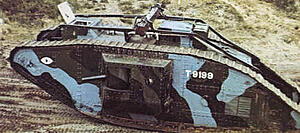The Battle of Amiens
The Battle of Amiens began on 8th August 1918 and proved to be the most decisive battle against the Germans to take place on the Western Front during World War One. It was also the first battle of the war to incorporate a completely co-ordinated attack involving all arms, including artillery, tanks, infantry and aircraft.
Amiens was of great importance to the Allies as it was a major rail hub and received supplies from the front line, and also resupplied other parts of the Western Front.
In early 1918, Ludendorff ordered a major attack on the city. With the help of an army strengthened by tens of thousands of troops from the Eastern Front following the withdrawal of Russia from the war.
Ludendorff made a plan to focus his forces in one part of the Western Front so he could create a hole in the Allied defences and force them to move their troops elsewhere. Ultimately, he planned to force them into the English Channel, and believed that the shock of losing the British would force the French to surrender. Ludendorff named his plan ‘the Emperor’s Battle’.

Ludendorff’s attack began at 04:40 on 21st March 1918. After a heavy artillery barrage of around five hours, German storm troopers were sent in to attack British lines. These men - considered to be elite - had achieved such high levels of preparation that they had maps of British positions sewn into the sleeves of their uniforms. They strategically attacked weak points and then rapidly moved on, leaving devastation in their wake.
Once the storm troopers had done their work, infantry followed on and by 12:00 one third of Britain’s troops facing the attack had been lost.
It took until 5th April for the Allies to hold up the advance, which allowed the Germans to get within 11 miles of Amiens. In fact, between the start of the battle and the day the Germans were halted, they had managed to advanced 28 miles.
However, this success was to be the undoing of the Germans as they had stretched their supply lines too far and men at the front were left without any supplies.
While the Allies took some time to regroup, by the summer of 1918 they were joined by men from the American Army, who began to counter the advances of the Germans in many areas across the Western Front.
One of the main targets for the Allies was Belleau Wood, where the Germans had dug in on high ground. On 6th June, men from the US Marine Corps attacked the Germans, but they were unaware of the well-placed machine guns that had been strategically located around the woods. It took six attacks for the US Marines to clear the wood and they lost 10,000 men in the process. However, the loss of the location for Germany was an enormous victory for the Allies and ensured they could not advanced further into France.
Once the Germans had been removed from Belleau Wood, the Allies concentrated their efforts on countering Ludendorff. Sir Henry Rawlinson was put in charge of this task and by July 1918 he had concentrated 350,000 Allied men along a 17 mile front to the east of Amiens.
Despite greatly outnumbering the Germans, Rawlinson learnt from his mistakes from the Somme and made use of the flat, dry land. He employed the greatest concentration of tanks in World War One and also ordered artillery commanders to hold back until the attack had begun, so as not to pre-warn the enemy.
Ahead of the attack, Rawlinson ordered a crackdown on security. Some information got through but Ludendorff dismissed reports of an Allied build up as incorrect.
At 04:20 on 8th August 1918, the attack began. Troops from Britain, Canada and Australia advanced under a creeping barrage from 700 artillery guns that moved 100 metres every three minutes. Heavy tanks were also used to attack German positions while smaller tanks probed German defences.
As the Allies advanced, Rawlinson also employed the help of 600 aircraft from the RAF to attack German positions by dropping phosphorous bombs.
By midday, Canadian and Australian troops advanced five miles and British troops also advanced, although the hillier northern sector made mobility trickier. The attack was so successful that Rawlinson ordered 20,000 cavalry troops to advanced. Despite having struggled in previous World War One battles, they took a huge amount of land and overwhelmed the Germans.
“The Germans were surrendering everywhere. We knew it was going to be the end of the war.”Major S Evers, Australian Corps.
The Germans lost more ground on this day than on any other day on the Western Front. By 12th August the battle had lost momentum but the damage had been sufficient to critically damage the German Army. Ludendorff told Wilhelm II that the war was lost.
MLA Citation/Reference
"The Battle of Amiens". HistoryLearning.com. 2026. Web.
